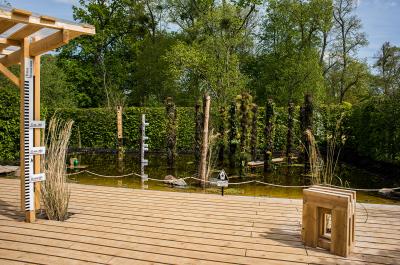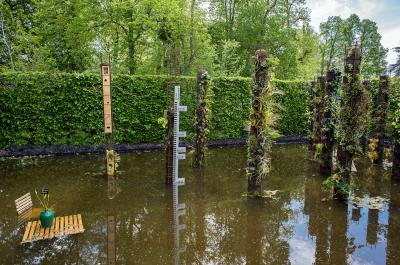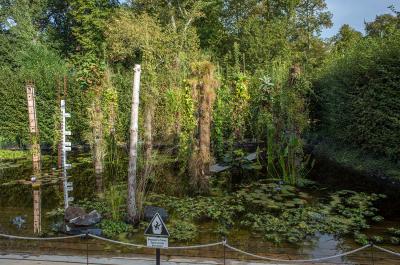23. NÉO-NOÉ
The designers of this garden have focused their research on fashioning a landscape reflecting contemporary concerns on environmental health and landscape blighting.
DESIGNERS
Thierry DUPEUX, architect, Alexandre MARTINET, landscaper, Julien GUÉNÉGUÈS, DPLG architect, Anaïs MOUREAU, designer, and Christian PIEL, urban planner and hydrologist
FRANCE

From left to right: Anaïs Moureau, Thierry Dupeux, Christian Piel, Julien Guénéguès and Alexandre Martinet
Thierry Dupeux willingly introduces himself as the grandson of farmers and son of a construction worker, thus offering up a double family link: Nature and Concrete in cities. He would combine these two worlds in his urban and architectural projects by incorporating biodiversity and the so-called "utilitarian" animal. Born in Poitiers in 1963, he graduated as an architect from the Brittany National School of Architecture in 1993, set himself up freelance in Rennes in 1995 and developed an environmental approach in his projects. He teamed up with Julien Guénéguès in 2012 to found the architecture and urban planning firm RHIZOME. He completed a High Environmental Quality engineering degree at Paris La Villette in 2004. This is when he began working alongside Christian Piel on urban projects with special emphasis on landscape. He has taken part in several symposia on urban biodiversity and teaches 2nd year Master's students at the University of Western Brittany on geo-architecture or biology courses. A teacher at the European Higher Arts School in Brittany since 1995 on the Design module, he became the DNSEP 2nd year Design Master's Coordinator and this is how he met Anaïs Moureau in 2014. A visual artist, working under the pseudonym "TDH macadam-trappeur", he tackles the anthropocene and looks at the Man/Animal relationship by using taxidermy as his main technique. He joined the group of artists Nos Années Sauvage in 2012 and has participated in many group exhibitions.
Julien Guénéguès is a DPLG-qualified architect with a degree from the Brittany National School of Architect earned in 2005. He became a partner in the architecture and urban planning firm Rhizome in 2012. A big travelling fan, he practised architecture as part of his training in Sweden at Stockholm's KTH School of Architecture before gaining his first professional experiences in Melbourne and Adelaide in Australia. Capitalising on these experiences abroad, he guides Rhizome in a constant thought process on architectural culture and its limits. Within his firm he has acquired a strong taste for varied projects, ranging from renovation to the most cutting-edge contemporary design. In his belief that architecture, urban planning and landscape are inextricably linked, and that they must draw inspiration from a variety of disciplines, in 2010 he co-founded Hémisphères, a multidisciplinary art platform. One of the platform's objectives is to enrich its architectural practice through experimentation and multidisciplinary collaboration, from the design stage right through to implementation. Since 2011 he has also taught students taking the Higher Applied Arts Diploma at Bréquigny sixth-form college in the Spatial Design section.
Alexandre Martinet was born and bred in Paris, which is still his home. A great enthusiast for wide open spaces, for mountains and for draughtsmanship, he has set increasing store by understanding the link between anthropisation and landscape. This prompted him to enrol in a landscaping degree at the Graduate School of Landscape and Garden Architecture in Paris, which he completed in 2004. He rounded off this training with a Master in 2005. After ten years working across various landscape studios, five of which he spent with Signes-Paysages, he is now going freelance. He contributes to all manner of projects in a whole host of disciplines, and for the past three months has clubbed together with Christian Piel on the themes of water and landscape. Advocating the contrast in aestheticism, he experiments with unprecedented combinations in his projects, spanning technology and plants. With harmonious composition a constant focus, Alexandre takes a simple constructive approach to incorporating the many requirements inherent in projects.
Born in 1988, in St Brieuc, Anaïs Moureau completed her two-year higher-education diploma in Spatial Design in Caen in 2009. She then enrolled in the European Higher Arts School in Rennes, Brittany, and graduated with a DNAP Design degree in 2013. The following year, she spent six months studying at the German Art School Muthesius Kunsthochschule, specialising in "Raumstrategien" (Spatial Strategies). Mindful of the question of landscape and environmental health and keenly interested in botany, the young designer is drawn to the idea of landscape "wounds". In her final year dissertation entitled "Le paysage blessé" (The wounded landscape), she asked herself: in what way can a landscape be wounded? And if it is considered as such, how can its value be restored? In 2015, she passed her DNSEP-Design degree with commendation from the jury. Her degree project, based on the research programme URU (Unicellular Regenerative Unit) and supervised by P. Lafon, a teacher at the European Higher Arts School in Brittany, in partnership with engineers (at INSA and GMP) and the Rennes Gardens Department, involved erecting a landscape installation. Anaïs seeks to restore the link between humans and nature. She presents an installation that can "repair" a pond which has become unfit for bathing, through the wastewater stabilisation technique. After her degree, she showcased some of her work, “Portique de cultures” (Portico in bloom), during the exhibition "Mettre à jour et Extension" at the Rennes Regional Contemporary Art Fund (Frac) in September 2015. She intends to open up her own studio to develop and expand this project which embraces landscape, design and environment in a positive and light-hearted approach.
A trained urban planner and a hydrologist, Christian Piel founded and for twenty years headed up the landscape firm Composante Urbaine, which specialises in making water a part of cityscapes. For two years now, through Urbanwater and in partnership with the urban hydrology engineering firm Sépia, he has been delving even deeper into this link between water and urban settings, this time at all scales. From sweeping landscapes, by taking on board such issues as flooding risks, to rain gardens, which reintroduce the water cycle into cities. Water forms a key component of the project in that it reveals geography and both supports and represents the landscape. Via the natural metabolism it restarts in urban settings, water also helps to provide solutions to such contemporary challenges as biodiversity or creating urban cool islands.



